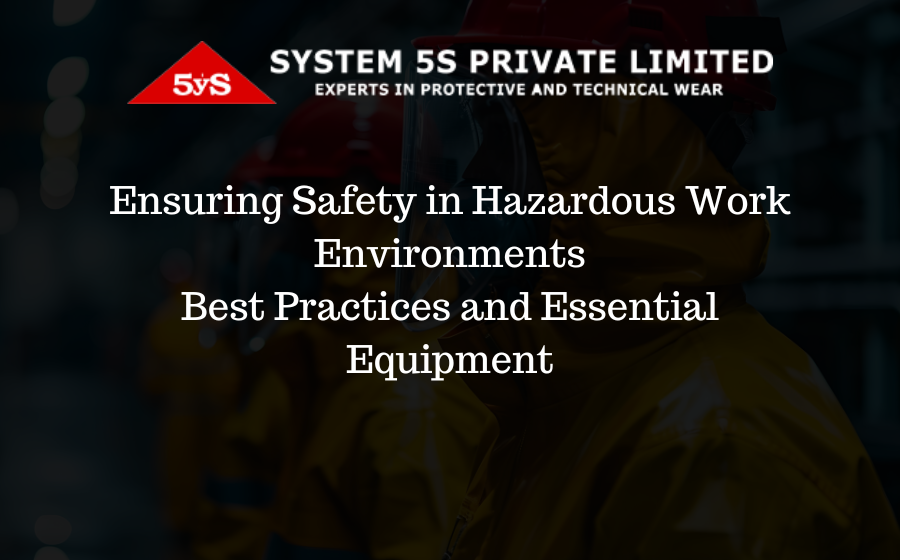In hazardous work environments, ensuring the safety of workers is paramount. Industries such as construction, manufacturing, oil and gas, and chemical processing are rife with potential risks that can lead to serious injuries or fatalities. Implementing best practices and equipping workers with essential safety gear are critical steps in maintaining a safe workplace. This blog provides a comprehensive guide to best practices for maintaining safety, details the essential safety equipment required for different industries, and offers tips on regular maintenance and inspection of safety gear to ensure optimal performance.
Best Practices for Maintaining Safety in Hazardous Work Environments
1. Conduct Thorough Risk Assessments:
- Regularly evaluate the work environment to identify potential hazards.
- Assess the severity and likelihood of each risk to prioritize safety measures.
- Update risk assessments periodically and after any changes in the work environment.
2. Develop and Implement Safety Protocols:
- Establish clear safety protocols and procedures for all tasks.
- Ensure that all employees are trained in these protocols and understand their importance.
- Regularly review and update safety protocols to reflect new risks or changes in regulations.
3. Provide Comprehensive Safety Training:
- Conduct regular safety training sessions for all employees.
- Include training on the correct use of safety equipment, emergency procedures, and hazard recognition.
- Offer refresher courses to ensure ongoing awareness and compliance.
4. Foster a Safety Culture:
- Encourage employees to prioritize safety and report any hazards or near misses.
- Recognize and reward safe behaviors and practices.
- Promote open communication about safety concerns and improvements.
5. Ensure Proper Signage and Labeling:
- Use clear and visible signage to indicate hazards, emergency exits, and safety equipment locations.
- Label hazardous materials and equipment with appropriate warnings and instructions.
Essential Safety Equipment for Different Industries
1. Construction:
- Hard Hats: Protect against head injuries from falling objects and debris.
- Safety Glasses/Goggles: Shield eyes from dust, debris, and chemical splashes.
- High-Visibility Clothing: Ensure workers are easily seen, especially in low-light conditions.
- Steel-Toed Boots: Provide foot protection against heavy objects and sharp materials.
- Fall Protection Gear: Include harnesses, lanyards, and anchor points for working at heights.
2. Manufacturing:
- Hearing Protection: Use earplugs or earmuffs to protect against loud machinery noise.
- Respirators: Protect against inhaling hazardous dust, fumes, and chemicals.
- Cut-Resistant Gloves: Prevent injuries from sharp tools and materials.
- Flame-Retardant Work Wear: Provide protection against fire and heat in high-temperature environments.
3. Oil and Gas:
- Fire-Resistant Clothing: Ensure protection against flash fires and explosions.
- Gas Detectors: Monitor and alert workers to the presence of hazardous gases.
- Chemical-Resistant Gloves: Protect hands from corrosive substances and chemicals.
- Safety Boots: Provide foot protection and prevent slips on oily or wet surfaces.
4. Chemical Processing:
- Chemical-Resistant Suits: Offer full-body protection against hazardous chemicals.
- Face Shields: Protect the face from chemical splashes and impacts.
- Gloves: Use appropriate gloves based on the specific chemicals handled.
- Emergency Showers and Eyewash Stations: Provide immediate decontamination in case of exposure.
Tips for Regular Maintenance and Inspection of Safety Gear
1. Conduct Routine Inspections:
- Regularly inspect safety equipment for signs of wear, damage, or contamination.
- Replace or repair any damaged equipment immediately.
2. Follow Manufacturer Guidelines:
- Adhere to the manufacturer’s instructions for the use, maintenance, and storage of safety gear.
- Ensure that all equipment is serviced and maintained according to recommended schedules.
3. Train Employees on Proper Care:
- Educate employees on the correct methods for cleaning and maintaining their safety equipment.
- Emphasize the importance of regular maintenance to ensure optimal performance.
4. Maintain Records:
- Keep detailed records of all inspections, maintenance, and repairs performed on safety equipment.
- Use these records to track the lifespan of equipment and plan for replacements.
5. Use Approved Cleaning Methods:
- Use only approved cleaning agents and methods for each type of safety gear.
- Avoid using harsh chemicals or abrasive materials that could damage the equipment.
- Ensure Wash, Care, Repair and Maintenance (WCRM) is done with experienced vendors like System 5S.
Ensuring safety in hazardous work environments requires a comprehensive approach that includes best practices, essential safety equipment, and regular maintenance and inspection. By conducting thorough risk assessments, developing and implementing safety protocols, providing comprehensive training, and fostering a safety culture, employers can significantly reduce the risk of accidents and injuries. Equipping workers with the appropriate safety gear and maintaining it properly is crucial for optimal protection.
At System 5S, we are dedicated to providing high-quality safety equipment designed to meet the rigorous demands of various industries. Trust us to supply the essential safety gear that your workers need to stay safe in hazardous environments. Prioritize safety in your workplace today and create a safer, more productive work environment for everyone.
